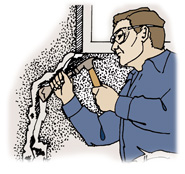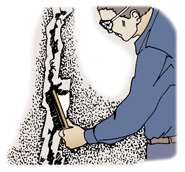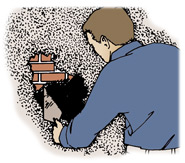|

FIG. 5 - Enlarge and
undercut a concrete wall crack with a cold chisel and hammer.

FIG. 6 - Clean the
undercut area with a stiff wire brush, but leave a rough surface.

FIG. 7 - Moistening
the area to be repaired prevents the newly applied patch from drying out.

FIG. 8 - Force the
concrete patch mix into the area with a pointing trowel.

FIG. 9 - Repair holes
in concrete walls the same way you repair cracks.
|

REPAIRING CRACKS AND HOLES
IN CONCRETE WALLS
- Repairing a crack in a concrete wall requires basically the same steps
as repairing a crack in a sidewalk or driveway.
- The cracked area must first be undercut and widened in basically the same
way as previously described for a sidewalk (Fig. 2).
- The widening and undercutting can be done with a cold chisel and hammer
(Fig. 5). The width and depth of the undercutting depends on the size
and length of the crack.
- After all loose material has been chipped away, thoroughly clean the undercut
area around the crack with a stiff wire brush (Fig. 6). Do not brush
the area enough to smooth off the edges. The rough surface created by
the chiseling provides a good bond for the new concrete you'll apply.
- When the enlarged area has been thoroughly cleaned, apply cement adhesive
with a brush. This is the same cement adhesive used when repairing sidewalks.
If you do not have a cement adhesive, prime the area with a thin, creamy
mixture of Portland cement and water.
- In some cases, you can make the patch by simply moistening the area thoroughly
before filling the crack with concrete (Fig. 7). Although the moistening
is important, a concrete adhesive or the mixture of Portland cement
and water is much more desirable than moistening with water only.
- You can use a ready-mix concrete patch for small cracks in cement walls.
Force the mixture into the cutaway area with a pointing trowel (Fig.
8). Be sure to use enough pressure to force the patch mix into all the
cutaway areas in the crack.
- It may be difficult to conceal the patch, since the finish on the old concrete
is difficult to duplicate. To conceal the patch, simply experiment with
matching the original finish by roughing up the patched area while it
is still workable. Try using an old broom, a float, or any other tool
to create the desired rough finish.
- You can patch holes and broken areas in concrete walls by simply clearing
out the hole in the same basic way you would undercut a crack.
- After the hole has been thoroughly cleaned and cut away, apply the cement
adhesive and insert the patch mix into the hole with a pointing trowel
(Fig. 9).
- Moisten the area and cure it after the patch is applied in the same way cracks in cement driveways or sidewalks are moistened and cured.
|














